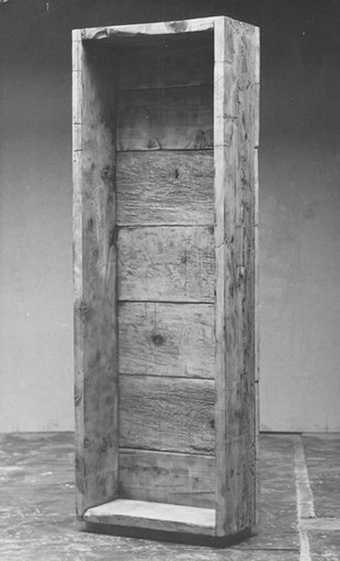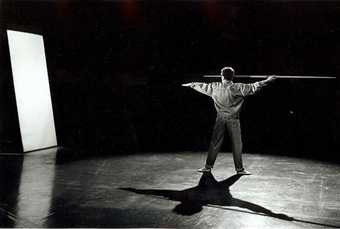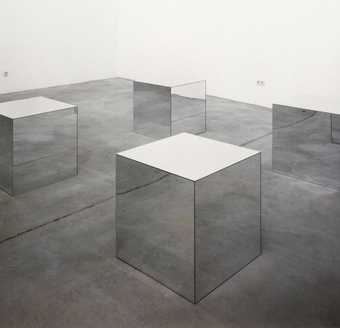
Robert Morris
Standard Terror 1981–7/2008
Wood, encaustic, felt flag (1981), 4 fibreglass casts (1987), oak bench, rubber buckets, lead, steel
259.08 x 274.32 cm
Photo: © Stephen Brayne
Image courtesy of the artist and Monika Sprüth Philomene Magers, Berlin London
Simon Grant
In the text ‘Indiana Street’, the wonderful essay on some recollections of your childhood growing up in Kansas, that appears in your most recent collected writings Have I Reasons, you wrote about a moment in the winter of 1935, when you were four years old, putting your fist through a window, and described your reaction as the ‘cardinal moment in my life’. Could you tell us more about this?
Robert Morris
It was a moment of fury and anger relieved by an act of bodily violence. No doubt I have lived a life of art-making by transposing and sublimating a fury that has never abated and rises ever anew: an unending source of energy.
Simon Grant
In this piece you also write about various scenes from your childhood that seem to echo, unwittingly or otherwise, elements of your work. In the house of Pop Harrison you played ‘amid the heaps of coloured fabrics that Lucille sewed into dresses’. And you write that you ‘became fixated’ on the shape of a hardwood blackboard pointer that Gene McEuen gave you. And you recall the ‘that malevolent black mound’ of coal that was dumped at your house. I wondered if such memories fed into how you worked with materials in your work?
Robert Morris
Early childhood experiences have always been central to my art making.
Simon Grant
In 1961 you moved to New York, and in that year, among other pieces the piece Passageway, in a loft on Chambers St., New York. Could you say a bit about how this work came about and why you made it?
Robert Morris
Forty-seven years ago I arrive in New York City and begin graduate studies in art history. Gradually I begin to make objects. The process of making accelerates and interest in art history lags. This rise of creativity is accompanied by increasing personal unhappiness. Marriage collapses. A certain mental energy and obsessive, single-minded concentration, bordering on a kind of possession, is addressed to questioning the premises of sculpture. This goes along with an increasing negativity toward and incapacity for personal relations. I move further into a kind of semi-autistic space which excludes the other. Such a space is familiar from childhood where it was constantly denied. Only the inanimate object is alive for me in these years, and making objects becomes my bulwark against the threat of the other, and every other is regarded as threatening, especially those who would try to get close to me. But I want more than the object. I want a totalising, enclosing space within which I exist with the object. I want to fashion a conceptual, mental, psychological and physical space. I want to make a world within which I alone move amongst my objects. Reading Wittgenstein’s remarks in the Tractatus that ‘I am my world. (The microcosm),’ my heart skips a beat. I make a 50-foot long plywood Passageway, which narrows as it curves. Two arcs of a circle converging. I wedge my body between the narrowing walls, which curve ahead and out of sight. I am suspended, embraced and held by my world. I listen to the faint sound of the hidden mechanical heartbeat I have installed over the ceiling of Passageway. There is nothing to look at here in this curving space which diminishes to zero. In this blind space whatever constitutes the ‘I’ of my subjectivity evaporates and I think of that other remark of Wittgenstein: ‘The subject does not belong to the world: rather, it is a limit of the world.’ Others who visit Passageway leave messages written on the walls such as ‘Fuck you too.’ I repaint the grey walls once a week. In these years my large insecurities are guarded and held closely. Perhaps they are the sources and engine driving my capacity to create. Never again will I lose myself in such blind and self-sufficient spaces. Never after am I as unhappy and as exhilarated as in these years.

Robert Morris
Box for Standing 1961
Courtesy Sonnabend Gallery © Robert Morris
Simon Grant
You have described Passageway ‘is a kind of tomb’ and Box for Standing as ‘coffin-like’ and have said that there is something ‘paranoid’ about the grey plywood works of the 1960s. What did you mean by these comments?
Robert Morris
Art as a closed space, a refusal of communication, a secure refuge and defence against the outside world, a dead zone and buffer against others who would intrude.
Simon Grant
Before you came to New York, you were involved with theatre and dance, including the workshop of Ann Halprin, and you married the dancer Simone Forti. How did your wife’s work influence you at the time?
Robert Morris
Forti is the most brilliant woman I’ve known. Her investigations into ‘ordinary movement’, the employment of objects and ‘rules’ to generate movement, her refusal of the narcissistic body, and the use of language in dance performance – all these things influenced me in the choreography I did. In more subtle ways, her strategic structural investigations involving the use of one set of things to generate results entirely different from the first set of intentions affected my work with objects and spaces. To put it in philosophical terms, perhaps such strategies with reference to intentionality stand as metaphors for the notion that naturalism does not extend to intentionality.
Simon Grant
You have eloquently described in various places, the movements of peoples bodies. You wrote that the iceman who used to ply his trade on Indiana Street – ‘his actions constituted a performance’, and elsewhere you wrote about the ‘swooping grace of my father’s movements’ in the Kansas stockyards. Did some of these sentiments feed into your pieces Arizona 1963 and Site 1964?
Robert Morris
Yes.
Simon Grant
You started making your felt pieces in 1967. How did these extraordinary works come about?
Robert Morris
I wanted to work in a way that would subvert a priori intentions. I wanted to find a way to generate unpredictable, indeterminate consequences. The first experiments were with ropes and rags, then thin felt, then heavy industrial felt. Of course I had proposed the work Steam before using felt.
Simon Grant
You have said that these pieces were made with a certain element of chance and gravity but they seem particularly shaped and formulated. How were the shapes decided?
Robert Morris
The early felt works had multiple positions – sometimes thrown on the floor or hung on the wall. But once the works were photographed nobody wanted to hear about alternative positions. And of course works on the wall are easier to deal with than things on the floor so the wall option became the preferred position. I suppose this illustrates Duchamp’s remark about how art quickly loses its aesthetic smell and becomes frozen and arid. Anyway some of the works involving many separate pieces could of course never be installed twice in the same way. These maintained their indeterminate status more than the works made of larger sections.
Simon Grant
You made several pieces using threadwaste, some that included mirrors. Why did you choose to use this material? Did it have any particular resonance?
Robert Morris
Threadwaste (multi-colored threads and bits of cloth) was saturated with oil and packed in the journal boxes of freight cars in the 1950s as a lubricant for the half-round bronze bearings in this primitive system (since changed to roller bearings). In the winter we switchmen would take handfuls of this oil-soaked threadwaste from a journal box, throw it in the little iron stoves of the tiny shacks located here and there in the freight yards, light it up, and in a few minutes the stoves would be glowing red and we would be warm.
Simon Grant
Your solo exhibition at the Whitney Museum in 1970 was a landmark exhibition in many ways – straddling performance, sculpture and installation. And there was much emphasis placed on using industrial materials, using workmen on a level footing with yourself. (There is a photograph of you using a forklift truck during the installation.) What were your intentions with this exhibition at the time?
Robert Morris
The Whitney wanted a retrospective but I thought 1970 was too early for me to have one. There was a lot of resistance to doing the show as I did it. I don’t think I really had much comprehension of what I was doing. I just wanted large objects falling down all over the place, wanted to devise strategies for inducing chance to help determine the forms. And I think I must have also wanted a whiff of an arena of labour recalling all those past, dangerous, physical jobs I had worked at.
Simon Grant
Why did you decide to close the exhibition?
Robert Morris
I was at the time also in a group show at the Jewish Museum. This was the time of the American bombing of Cambodia. The artists voted to close that exhibition in protest. I felt I had no option but to close the Whitney show as well.
Simon Grant
The following year you had your first solo exhibition in the UK at the Tate (now Tate Britain). Here, the exhibition comprised of what was effectively a single work spread over 9,000 square feet made of loosely assembled lumps and plates of metal, sandbags, timber beams sheets of plywood. Its curator Michael Compton described it as ‘a contemplative gymnasium’. What ideas were you hoping to put across with this exhibition?
Robert Morris
The works were based on progressive physical difficulty as one proceeded toward the end of the space. Objects to handle gave way to things to balance on and then to climb on or in. I wanted a situation where people could use their bodies as well as their eyes.
Simon Grant
Compton later wrote that he ‘wondered at the time whether the artist’s strategy had been to test the institution’s power and willingness to deal with art to the point where their limits would be defined…to make a political point’. What was your view at the time, particularly in light of the experiences at the Whitney?
Robert Morris
Michael Compton never wavered in his support of getting the show up as I had designed it. Of course once opened a lot of noise and physical activity were going on inside the then rather staid Tate Museum. I spent a month directing the construction of the works and then went home. Five days later the Tate called to tell me the show had been closed because the public was behaving ‘hysterically’.

Robert Morris
Arizona 1963
Courtesy Sonnabend Gallery © Robert Morris
Simon Grant
When you were at art college, Eugene Jamieson introduced you to surrealist technique and automatic drawing. Did he have any influence in the genesis of your ‘Blind Time’ drawings?
Robert Morris
I never made that connection between the Blind Time Drawings and Jamieson’s classes in automatic drawing some 24 years before, but it may have been there unconsciously all along. I have tried to address the elusive, exhilarating, threatening space of drawing blind in the essay ‘Drawing with Davidson’.
Simon Grant
In 1982, your style and method shifted – and you begun your series of paintings and watercolours encased in elaborately and intricately worked cast Hydrocal frames. The content of these works, featuring firestorms, skulls, seems dark, foreboding, even apocalyptic. How did this series come about?
Robert Morris
While my early plywood works mocked modernism, perhaps I finally woke up to how appalling it was to have addressed it at all. This thought freed me to do other things.
Simon Grant
What sources fed into the apocryphal content of this work? Was in it in some way, part ‘Ars Moriendi’, part message for our times?
Robert Morris
Sources? The 20th century. The one Elizabeth Bishop called ‘The worst so far.’
Simon Grant
Could you tell me a little about the impetus for the content of your recent works at Spruth Magers gallery, London?
Robert Morris
I just could not not make these four works. I felt forced to make them. I felt I had no choice. Maybe that is too dramatic an answer. It sounds like posing. But I felt I had to, in my little art way which affects nothing, deal with my shame and anguish… Something to do with the shame of our barbaric and genocidal American foreign policy.
Simon Grant
You once said that your repertoire is ‘confinement, paranoia, entropy, personal trauma’. How about now?
Robert Morris
Probably much the same.
Simon Grant
You have been variously described as a minimalist, performance artist, land artist, neo-Dada-ist, conceptual artist and expressionist’ Do these definitions mean anything to you?
Robert Morris
Nothing. Zero. What a list… I can’t help recalling here Nietzsche’s remark about constantly suffering for what things are called as opposed to what they are.

